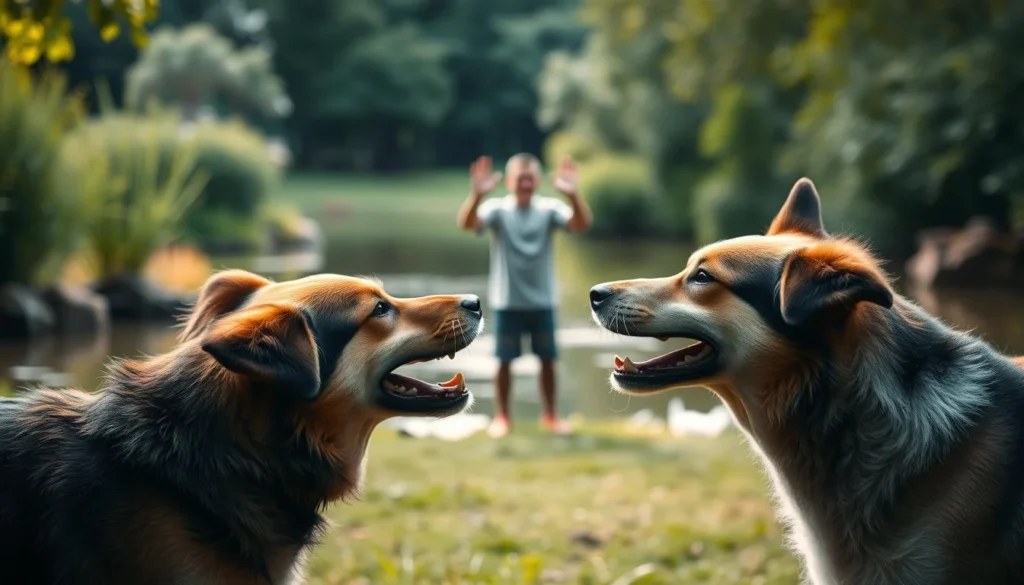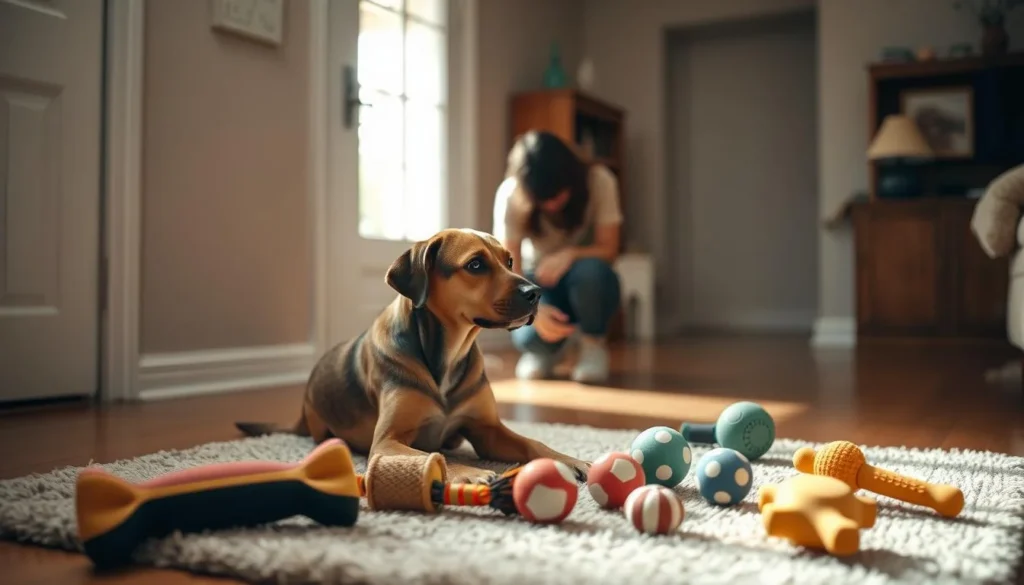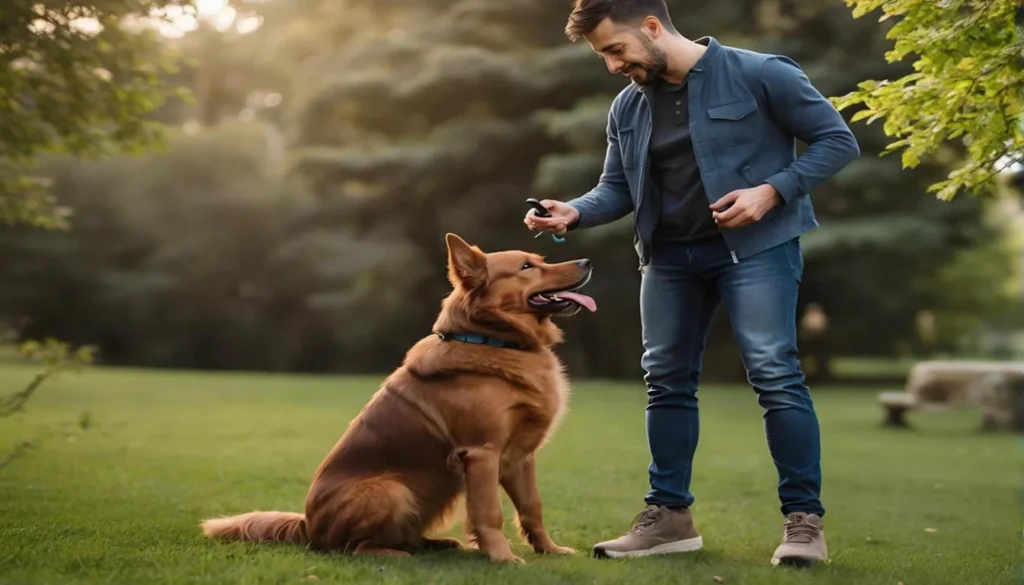I remember the first thunderstorm that scared my Labrador, Rosie. She ran under the bed, her paws sliding, eyes wide. My heart was racing with hers. I felt helpless until I found calming aids for dogs.
I tried diffusers, a ThunderShirt-like wrap, and melatonin under my vet's watch. Some worked a bit, others not at all. But a few really helped Rosie on stormy nights.
Pet parents seek calming aids for dogs with anxiety for many reasons. This includes separation anxiety, fireworks, vet visits, travel stress, or midnight wake-ups. The market offers many options like chews, pheromone diffusers, supplements, and toys.
But, not all these products have strong scientific backing. That's why I always talk to my vet first. We discuss the dog's breed, age, allergies, and the situation. This helps us choose the right calming aid.
Some dogs do well with supplements or pheromones. Others need behavior changes and enrichment. It's all about finding what works best for each dog.
Key Takeaways
- Calming aids for dogs can help but results vary by dog and product.
- Consult your veterinarian before trying supplements or new treatments.
- Common supported ingredients include L-theanine, melatonin, alpha-casozepine, and certain probiotics.
- Pheromones and pressure vests may provide situational relief for storms or travel.
- Interactive toys and enrichment support long-term natural dog anxiety relief.
Understanding canine anxiety and when calming aids help
I start by watching a dog's daily habits. Small changes can point to a bigger problem. Noticing when a pet gets stuck in a behavior loop helps me decide whether simple stress relief for dogs will work or if I need more targeted help.

I look for clear signals of fear and anxiety. Excessive barking or howling is one of the first things owners mention. Pacing, spinning, trembling, hiding, or destructive chewing are common signs. Some dogs become clingy, others soil the house or lose their appetite when anxious.
Older dogs may show restlessness at night or changes that mimic cognitive decline. Escape attempts and repetitive jumping show high stress. Seeing several signs together raises my concern about whether over-the-counter dog anxiety products will help.
Common signs of fear and anxiety in dogs
I teach owners to watch for body language and routine changes. Look for panting without exercise, tucked tail, flattened ears, and dilated pupils. A sudden dislike of routines they used to enjoy can mean worry is increasing.
Vocalization, pacing, restlessness, and destructive behavior often come in clusters. When these behaviors appear during specific events, they usually point to situational triggers rather than a medical cause.
Situational triggers: storms, fireworks, vet visits, travel, and separation
Loud noises like thunderstorms and fireworks trigger noise phobias in many dogs. Vet visits, car travel, and boarding can cause situational anxiety. Separation anxiety shows when a dog acts fine with you home but panics when you leave.
I recommend timing interventions around predictable stressors. For example, offer a food puzzle before fireworks to shift focus. Identifying triggers helps me choose calming aids for dogs with separation anxiety or short-term stress relief for dogs during storms.
When to seek veterinary or behaviorist help before trying calming products
I always advise a vet check first. A veterinarian can rule out pain, thyroid issues, or other medical causes that mimic anxiety. They can also grade the severity and suggest behavior modification, prescription medication, or a referral to a board-certified veterinary behaviorist.
If behaviors are severe, persistent, linked to trauma, or include injuring people or pets, I recommend professional help before relying on calming aids for dogs with anxiety. Over-the-counter dog anxiety products may ease mild stress, but they rarely replace structured behavior plans or prescription treatments in chronic cases.
Calming aids for dogs
I sort products by purpose, speed, and science. This helps match a tool to a dog's needs. Below, I outline categories, research, and how to start.
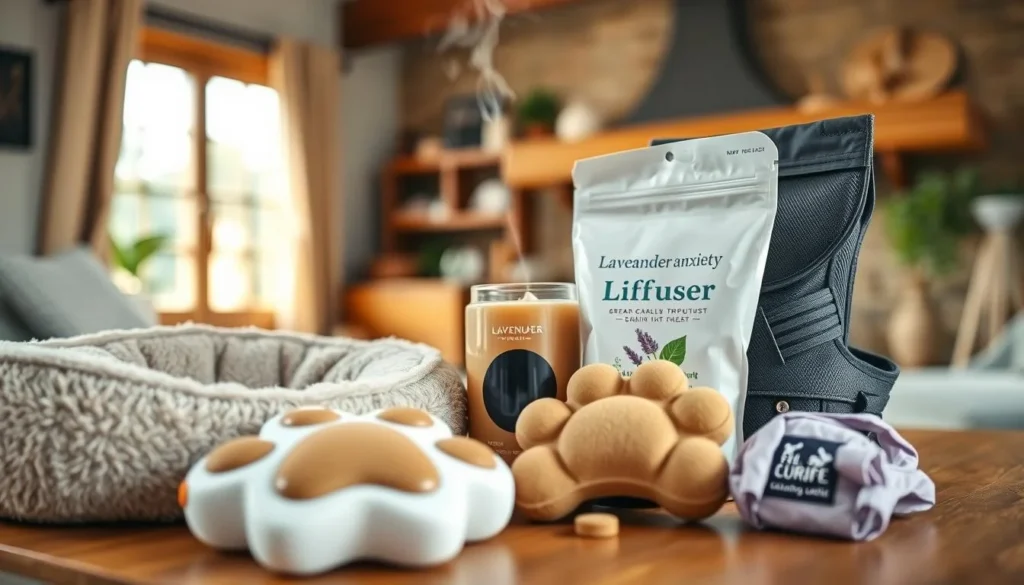
Overview of product categories
Oral supplements and chews include L-theanine, L-tryptophan, and melatonin. They also have alpha-casozepine, herbal blends, and probiotics like Bifidobacterium longum BL999. You can find calming chews, powders, tablets, and diets like Purina Pro Plan Calming Care.
Pheromone products are available as Adaptil DAP diffusers, sprays, and collars. They mimic the dam-puppy scent to ease stress. Pressure vests and anxiety jackets, like ThunderShirt-style wraps, apply gentle pressure to reduce arousal.
Interactive solutions include KONG toys, snuffle mats, and food-dispensing puzzles. You can also use frozen-filled toys, heartbeat toys, and calming music for dogs. These help reduce fear during storms or at night.
Evidence and limitations
Some ingredients have blinded or placebo-controlled support. L-theanine, melatonin, alpha-casozepine, and BL999 show measurable effects in trials. Calming chews with these agents can work when dosed correctly.
Pheromones have supportive studies, but methodology varies. Results show modest benefit for some dogs but not all.
Pressure vests deliver mixed results. Small studies and owner reports suggest mild improvement in certain cases. Expect variability and remember many commercial supplements lack FDA-like oversight.
Quality signals like the NASC seal help identify reputable manufacturing. Efficacy differs across brands. Owner expectation and placebo effects can influence perceived outcomes.
How I decide which category to try first for my dog
I first assess trigger type and severity. For acute events like fireworks or a single vet visit, I use short-acting options. These include pheromone sprays, fast-acting calming chews, a frozen KONG, or a temporary diffuser.
For chronic, low-level anxiety, I prefer daily, evidence-backed supplements. I choose L-theanine or alpha-casozepine products and a probiotic like BL999. I run a 4–6 week trial while tracking behavior.
For situational tension around travel or thunderstorms, I combine tools. I use a pheromone diffuser at home, an anxiety jacket during the event, and enrichment toys to redirect focus.
I always check for drug interactions, contraindications, and toxic additives. I consult my veterinarian when anxiety is severe or when prescription medications may be needed.
Dog calming supplements and ingredients backed by research
I look at ingredients for dog calming supplements when owners ask. I focus on those with scientific backing, dosing info, and real-world use. This helps you and your vet make informed choices.
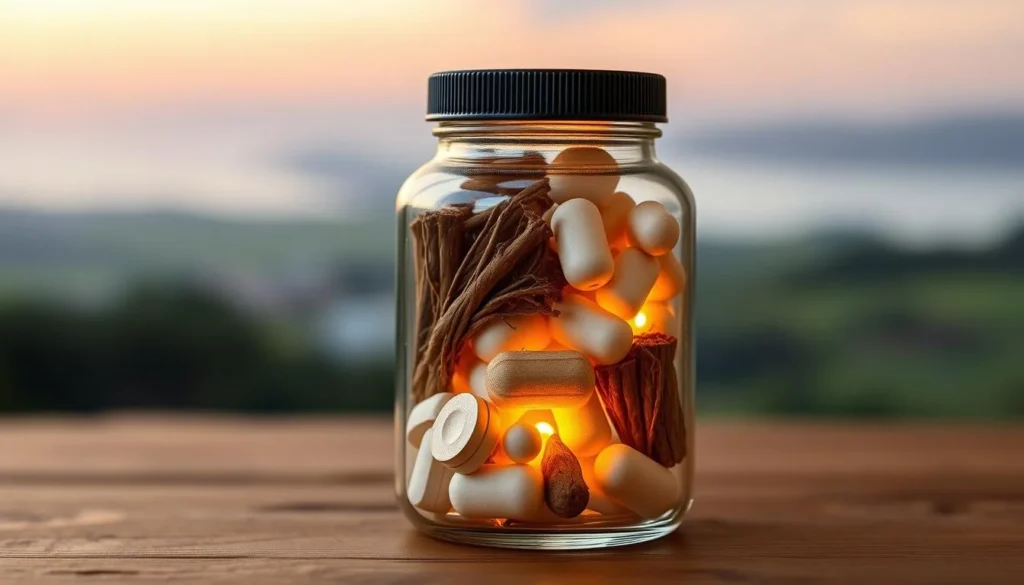
L-theanine: sources and typical uses
L-theanine comes from tea and is found in products like Solliquin and Composure. It helps dogs with noise or stranger fear, as studies show it reduces stress signs. Most chew formulas include it. Expect to see benefits in 4 to 6 weeks with daily use.
L-tryptophan and serotonin support for mood regulation
L-tryptophan is a serotonin precursor in some calming diets and chews for dogs. It has shown to reduce fear in some trials, but results can vary. I pair it with behavior work and watch for appetite and activity changes over 4 to 6 weeks.
Melatonin for nighttime restlessness and situational anxiety
Melatonin helps dogs sleep better and can calm them during storms or vet visits. It's good for senior dogs with nighttime issues. But, avoid human melatonin products with xylitol. Side effects like mild sedation or stomach upset can happen, so always check with a vet first.
Alpha-casozepine, GABA modulation, and products that contain it
Alpha-casozepine is a milk derivative that affects GABA pathways. It's in Zylkene and some veterinary diets. It helps with short-term situational anxiety, especially with stranger fear. I see it as a tool in a broader plan, not a cure-all.
Probiotics and the gut-brain axis: Bifidobacterium longum BL999 evidence
Probiotics work on the gut-brain axis. Purina Pro Plan Calming Care with Bifidobacterium longum BL999 helped Labradors with anxiety in trials. Effects may take weeks. I consider probiotics for dogs with chronic anxiety and dietary sensitivities.
Practical notes I share with owners: most trials last 4 to 6 weeks. Dosage varies by product, and interactions with meds are possible. Always consult a vet before starting supplements, especially for pregnant, nursing, or dogs with health issues.
| Ingredient | Common Brands or Forms | Typical Use Case | Time to Effect | Notes |
|---|---|---|---|---|
| L-theanine | Solliquin, Composure, Anxitane, many chew formulas | Noise phobia, stranger fear, general anxiety | 4–6 weeks | Daily dosing; well tolerated; often in best calming treats for dogs |
| L-tryptophan | Veterinary calming diets, supplement chews | Mood regulation, fear reduction | 4–6 weeks | Precursor to serotonin; efficacy varies by formulation |
| Melatonin | Dog-specific tablets, chewables | Nighttime restlessness, situational fears (storms, vet visits) | Hours to days for sleep; behavioral changes over weeks | Avoid human products with xylitol; consult vet for dosing |
| Alpha-casozepine | Zylkene, some veterinary diets | Stranger fear, situational anxiety | Days to weeks | Acts on GABA pathways; best as part of multi-modal plan |
| Bifidobacterium longum BL999 | Purina Pro Plan Calming Care powder | Chronic anxiety, excessive vocalization, pacing | Up to 6 weeks | Promising gut-brain results in Labradors; consider with diet |
Herbal and natural options: benefits and cautions
I explore herbal and natural options when owners seek gentle ways to ease their dog's stress. I start with mild, well-studied botanicals. I also check labels carefully before recommending any product for natural dog anxiety relief.
First, I consider valerian, chamomile, and passionflower. Valerian root acts as a mild sedative and helps with sleep in restless dogs. Chamomile soothes GI upset and promotes calm on a short-term basis. Passionflower is used for acute anxiety and offers rapid relief for specific triggers.
Magnolia officinalis and phellodendron amurense are found in some veterinary formulas. Research suggests they have anxiolytic effects. Products like Solliquin include these ingredients and have shown reduced fear in thunderstorm trials, though results are not universal.
I approach hemp seed oil and full-spectrum or broad-spectrum CBD products with caution. Hemp seed oil contains no THC and is used in calming treats for dogs. Brands like Open Farm use Canadian hemp seed oil in soft chews aimed at relaxation.
CBD for dogs has mixed evidence. Some studies report lower cortisol or improved mobility with pain modulation. Case reports note adverse effects and inconsistent formulations. Dosing and interactions with other medications remain unsettled, so I tell owners to consult their veterinarian before trying CBD.
Reading labels is a habit I insist on. Human supplements can contain xylitol, which is highly toxic to dogs. Some calming formulas include garlic or other unsafe additives that raise red flags for me.
I avoid recommending products for pregnant, immature, or lactating animals without vet approval. High doses of some botanicals may cause GI upset or diarrhea. I advise caution when combining herbal sedatives with prescription CNS depressants or prior to anesthesia.
Below I compare common natural ingredients, typical uses, and safety signals I watch for when assessing calming chews for dogs or calming treats for dogs.
| Ingredient | Common use | Evidence | Safety signals |
|---|---|---|---|
| Valerian root | Mild sedative; helps sleep and restlessness | Some trials show reduced intensity of anxiety behaviors | Sedation, GI upset; avoid with other sedatives |
| Chamomile | Soothes GI upset; mild calming effect | Traditional use; limited clinical trials in dogs | Allergic reaction in sensitive animals; possible drowsiness |
| Passionflower | Acute anxiety relief for situational stress | Some positive outcomes in short-term use | Drowsiness, interaction with sedatives |
| Magnolia + Phellodendron | Used for fear and storm-related anxiety | Animal studies and commercial product trials show benefit | GI upset at high doses; check product sourcing |
| Hemp seed oil | General relaxation; ingredient in calming chews for dogs | No THC; supports relaxation in anecdotal reports | Few direct risks; watch for formulation purity |
| CBD (full/broad spectrum) | Stress reduction, pain modulation | Mixed results; cortisol and pain outcomes reported | Variable dosing, drug interactions, occasional adverse reports |
| Label hazards | Not an ingredient but critical to review | NASC seal and transparent sourcing improve trust | Avoid xylitol, garlic, unclear origins; check vet guidance |
Dog pheromones and calming diffusers
I use pheromone tools for quick, low-risk support for nervous dogs. Dog-appeasing pheromone (DAP) mimics a nursing mother's scent. It affects the brain to calm dogs. Studies show it can reduce fear, but results vary.
How DAP works biologically
DAP signals safety to a puppy’s brain. The scent reaches the vomeronasal organ and changes brain activity. This can lower arousal and stress.
Product formats: diffusers, sprays, and collars — pros and cons
Diffusers, like Adaptil plug-ins, cover rooms and kennels. I choose them for home setups to manage ongoing anxiety. They work well in daily routines.
Sprays fit crates, cars, and travel. They start working fast but last a few hours. Owners should wait 15 minutes after spraying for the alcohol scent to fade.
Collars offer portable, steady release. Brands like Adaptil have collar options for dogs away from home. Fit and replacement schedule are key. I test fit and watch for wear before recommending for walks or vet visits.
Practical tips for using pheromone products effectively
I place diffusers in the main room where the dog spends most time. For separation anxiety, I use a diffuser with behavioral work and short departures. Pheromones alone rarely solve severe cases, but they offer gentle support.
When storms approach, I start pheromone use early. Pairing pheromones with enrichment—like puzzle feeders and safe spaces—boosts results. I monitor response for two to four weeks and adjust as needed.
I follow product instructions for placement and replacement. For sprays, I let alcohol dissipate. For diffusers, I respect room coverage limits. For collars, I replace them as directed. If a dog shows no change, I try combined strategies with a vet or behaviorist.
Pressure vests and anxiety jackets
I suggest pressure wraps for a calming aid at home. They work well for dogs scared of storms and fireworks. Look for a calm body, lowered panting, and relaxed posture.
I explain how they work before owners buy. The snug pressure feels like a hug. It may calm the dog by stimulating neural pathways and reducing fear.
How pressure wraps are thought to help
A gentle, even compression soothes some dogs. It lowers arousal and stress signals. Animal behaviorists say it can interrupt panic.
Evidence summary: benefits, limitations, and owner perception
Research on pressure vests is limited and mixed. Some studies show small improvements in behavior and heart rate. Owners often report visible benefits during fireworks.
Studies vary in quality. The effect size is usually small. I recommend trying a pressure vest as part of a plan, not a cure.
Fit, safety, and acclimation tips I use before leaving my dog unsupervised
Fit is key. Use the two-finger rule to check snugness. The vest should not restrict breathing or movement.
I never force a dog into a wrap. Some dogs dislike it and may become more stressed. Start with short, positive sessions and reward calm behavior.
Before leaving a dog unsupervised, confirm successful short sessions. Only then consider wearing a vest during a noisy event. If worried, consult a vet or certified behaviorist.
| Topic | What I look for | Practical tip |
|---|---|---|
| Fit | Snug with two fingers’ clearance; full mobility | Measure chest and follow manufacturer size chart |
| Acclimation | Short, positive sessions; no forced wear | Use treats and play while vest is on for 5–10 minutes |
| Effectiveness | Owner-reported calm in many dogs; mixed study results | Combine with training, enrichment, or other products |
| Safety | Monitor breathing, movement, and stress signs | Do not leave unsupervised until multiple successful trials |
| When to use | Storms, fireworks, short vet trips, mild separation anxiety | Pair with calming aids for dogs during fireworks for best results |
| Brand note | Widely used options include ThunderShirt | Consider trial periods and return policies before purchase |
Interactive solutions: toys, puzzles, and environmental strategies
I use hands-on tools to reduce stress and keep dogs busy. Interactive approaches help dogs react better to triggers. This makes nights calmer for everyone.
Food-dispensing toys, snuffle mats, and long-lasting puzzle ideas
I choose brands like KONG and Zogoflex for durable toys. Fill KONGs with peanut butter or canned food and freeze them. This makes a single toy last 15 minutes or more.
Snuffle mats slow down eating and encourage foraging. I keep several pre-filled and frozen for predictable stressors. This includes travel, thunderstorms, or fireworks.
Using enrichment to build positive associations with triggers
I teach counter-conditioning by pairing a favorite puzzle or treat with a stressful cue. Give the toy before the stressor starts. This redirects focus and prevents escalation.
For separation anxiety, I leave foraging-based activities and gradually desensitize departures. Start training when your dog is calm. If a dog refuses food under high anxiety, begin enrichment training in low-stress settings.
Calming music and sound therapies for dogs at night or during storms
I use calming music for dogs and white-noise tracks to mask loud sounds. Specialized playlists and programs are effective when paired with pheromone diffusers during firework nights.
At bedtime, I run soft instrumental playlists to help with restlessness. For severe cases, sound therapy helps lower startle responses. It supports other calming aids for dogs at night.
When I combine calming toys for dogs, targeted sound therapy, and planned interactive enrichment for separation anxiety, the results are more consistent. Using any single tool alone is not as effective.
Choosing, combining, and monitoring calming products safely
Before adding new products, I check the basics. I ask my vet to rule out medical issues and confirm safe dosing. This ensures I'm focusing on true behavioral support.
Talking to your vet: why it matters and what to ask
I take a list to vet appointments. I ask for a medical check, discuss risks with certain drugs, and confirm safety for puppies or pregnant dogs. I also ask about trial lengths and if a behaviorist referral is needed.
Combining supplements, pheromones, and behavioral strategies responsibly
I use a multi-modal approach with training and enrichment. For mild to moderate anxiety, I use pheromone diffusers, pressure vests, and supplements. I avoid mixing too many products without vet advice and be careful with sedatives.
How long to trial a product and how I track progress
I give most supplements four to six weeks to work. Probiotics like Bifidobacterium longum BL999 might need up to six weeks. Pheromones and vests can work faster, but results vary.
I track vocalizing, pacing, destructive behavior, sleep, appetite, and engagement. I keep a daily diary and sometimes video my dog. This helps me see real changes and avoid thinking it's just a placebo.
Quality indicators: NASC seal, ingredient transparency, and manufacturer claims
I choose products with the NASC seal for quality and clear ingredients. I avoid xylitol, garlic, and other harmful additives. I prefer brands with published trials like Purina Pro Plan Calming Care.
I look for honest dosing and cautions. When using calming treats, I start with a low dose and increase as needed. This ensures safe and effective natural anxiety relief for my dog.
Conclusion
Calming aids for dogs can be helpful if used carefully. Always start with a vet visit to check for health issues and talk about possible side effects. I suggest using supplements like L-theanine and melatonin, along with pheromones and enrichment, based on the dog's needs.
Remember, no single product works for every dog. Give each method a few weeks to see if it helps. Watch out for ingredients like xylitol and garlic, and be aware of pregnancy warnings and side effects.
For dogs with nighttime anxiety, try timed melatonin or a consistent routine with calming music. For those with separation anxiety, mix behavioral plans with supplements or pheromones. Choose products that match your dog's issue and track how they do.
Look for brands that are open about where they get their ingredients or are certified by the NASC. If your dog's anxiety is severe or doesn't get better, see a vet behaviorist. They might recommend prescription options. With the right approach, you can help your dog feel calm and relaxed for a long time.


